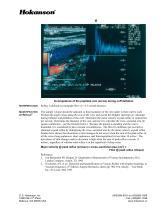 Website:
D. E. Hokanson
Website:
D. E. Hokanson
Catalog excerpts

VENOUS REFLUX TESTING USING THE HOKANSON E20 / AG101 RAPID CUFF INFLATOR AND DUPLEX SCANNING DESCRIPTION Venous reflux, one of the major causes of chronic venous insufficiency, has been studied using duplex scanning and segmental examination of the venous system of the lower extremity. The reflux-provoking test maneuver can be standardized by the use of pneumatic cuffs, which are automatically inflated by the Hokanson E20 / AG101 Rapid Cuff Inflator. Incompetent valves will allow reflux when the cuff is rapidly deflated. An advantage of this maneuver is its applicability to all levels of the limb. Using a valsalva maneuver to cause reflux decreases in effectiveness with increasing distance from the abdomen. Manual compression distal to the valve under study is also possible in a standing patient, but varies with examiner, and it is usually necessary to use both hands to effectively empty a segment of the leg. Therefore a standardized compression using cuffs and controlled inflation/deflation is preferable. Have the patient stand so that the study leg is relaxed. Their weight should be supported by the contralateral leg to prevent external compression of the popliteal vein. This can be achieved with the patient standing on a platform designed to allow the study leg to dangle, or with the patient standing with support from an orthopedic frame. Place a large cuff (Hokanson CC17™ or CC22™) around the thigh and connect it to the large hose of the E20 Rapid Cuff Inflator. For reliable compression of deep veins in a large thigh, make sure the width of the cuff is sufficient to prevent dissipation of pressure in the soft tissue. Typically, the width of the cuff should be equal to the diameter of the limb. Preset the pressure on the E20 Rapid Cuff Inflator to 80 mmHg. Using the duplex scanner transducer, locate the common femoral vein proximal to the cuff and position the sample volume. Using the E20, rapidly inflate the cuff for 3 seconds, then deflate it rapidly. (This maneuver can be simplified by using the Hokanson 3-Second Timer with the E20). Repeat this procedure with the sample volume positioned in the superficial femoral vein and the proximal part of the greater saphenous vein (GSV). Then, remove the large thigh cuff and apply a 12 cm (Hokanson SC12D™) cuff below the knee to examine the popliteal vein. Preset the pressure on the E20 to 100 mmHg, and test the popliteal vein. The lesser saphenous vein (LSV) is tested the same way. On the medial side of the knee, locate and test GSV. Then move the cuff to the level of the ankle. Using the same preset pressure of 100 mmHg, test the deep calf veins. With a color flow Doppler with a 5 MHz transducer, visualize both the posterior tibial veins and peroneal veins from the medial aspect of the leg. Apply a 7 cm (Hokanson TMC7™) metatarsal cuff around the foot. Preset the E20 pressure to 120 mmHg. Locate and test the two posterior tibial veins. Duplex examination at the knee level. Testing the left popliteal vein. D. E. Hokanson, Inc. st 12840 NE 21 Place Bellevue, WA 98005 USA
Open the catalog to page 1
Incompetence of the popliteal vein (arrow) during cuff deflation. INTERPRETATION Reflux is defined as retrograde flow of > 0.5 second duration. The sample volume should be adjusted so that insonation of the vein under is from wall to wall. Position the angle cursor along the axis of the vein, and record the Doppler spectrum on videotape during inflation and deflation of the cuff. Determine the mean velocity at peak reflux in centimeters per second. Determine the diameter of the vein, and use it to calculate the cross–sectional area (in square centimeters – see the formula below). Because...
Open the catalog to page 2All D. E. Hokanson catalogs and technical brochures
-
Vascular Cuffs
4 Pages
-
Hokanson Catalog
39 Pages
-
ABI Kit
2 Pages
-
DICOM Extension Brochure
2 Pages
-
OB1 Brochure
2 Pages
-
Portable ABI Kit Brochure
2 Pages
-
TBI Package
2 Pages
-
Toe Pressure Kit
2 Pages
-
UW7 Brochure
2 Pages
-
MD6 System
2 Pages
-
CVS4
4 Pages
-
ANS2000
2 Pages
-
3-second Timer - E20/AG101
1 Pages
-
General catalog Hokanson - EN
20 Pages


















